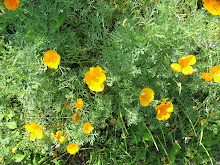There are many angles to explore on this issue, but for the moment I'll focus on what is most relevant to this blog: How has the Minton Stable Garden officially ensured that the soil is within acceptable levels?
When the garden was redesigned and landscaped in 2004, about 100 cubic yards of the original soil was taken away. This concerned some who were involved in the planning process because of all of the efforts made over the previous years to mix soils from problem spots with safer soils to bring down the lead levels in all areas to safe limits. However, the new soil that was trucked in was also tested and found to have levels within the acceptable limits (300 parts per million).
Soil for the non-plot areas (including the play areas) as well as the extra compost that gardeners can help themselves to has come from Apple D'Or Tree, a landscape company based in Southboro that has a green waste recycling facility on American Legion Highway in Mattapan. The play area soil tested within the safe limits for play area use, and in the past the garden has rejected soil from another source that did not test low enough.
That's the official story as I know it about lead levels in the garden; I'd be curious to know if individuals have tested their plots. One purpose of this blog is to hold myself accountable for learning more about my garden, so I have put "soil test for stable and backyard" on my to-do list, and I'll report on my findings at a later time.


No comments:
Post a Comment